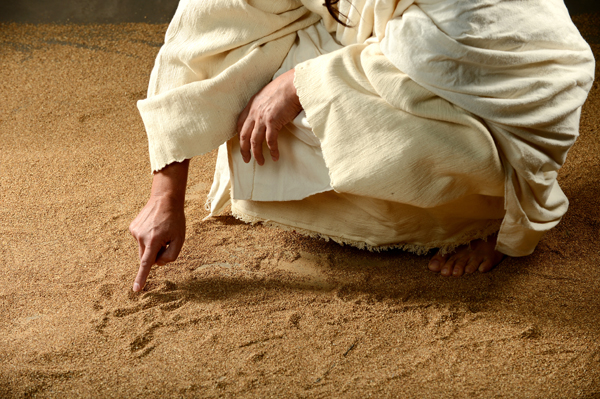Mysteries Revealed: Jesus and the Woman Caught in Adultery
The conversations of Jesus are different from his parables. The parables tend to be more generic, more applicable to different persons and circumstances. They also are presented in figurative language. The conversations of Jesus, on the other hand, are more concrete and direct. They show Jesus engaged with real, historical individuals, and these encounters are not described in metaphors or figurative language. For this very reason, they can strike the reader more forcefully and immediately. The reader can put himself in the shoes of the person with whom Jesus is speaking.
There is a transforming power in the conversations of Jesus that is not found in the same way as in his parables. And although they lack some of the universal applicability of the parables, nevertheless, read in their spiritual sense, the persons and events described in each conversation can be taken as types of larger realities. An excellent example of this is found in the conversation surrounding the woman caught in adultery found in the eighth chapter of St. John’s Gospel.
Jesus went to the Mount of Olives. But early in the morning he arrived again in the temple area, and all the people started coming to him, and he sat down and taught them. Then the scribes and the Pharisees brought a woman who had been caught in adultery and made her stand in the middle. They said to him, “Teacher, this woman was caught in the act of committing adultery. Now in the law, Moses commanded us to stone such women. So what do you say?” They said this to test him, so that they could have some charge to bring against him. Jesus bent down and began to write on the ground with his finger. But when they continued asking him, he straightened up and said to them, “Let the one among you who is without sin be the first to throw a stone at her.”
Again he bent down and wrote on the ground. And in response, they went away one by one, beginning with the elders. So he was left alone with the woman before him. Then Jesus straightened up and said to her, “Woman, where are they? Has no one condemned you?” She replied, “No one, sir.” Then Jesus said, “Neither do I condemn you. Go, and from now on do not sin anymore” (John 8:1-11).
The Context
The eighth chapter of John’s Gospel takes place in the temple, and it begins and ends with an attempted stoning. At the beginning, the Pharisees attempt to stone the woman; by the end, there is an attempt to stone Jesus. This is already instructive, for if we begin by judging our neighbor, we may end by judging Christ himself.
The Literal Sense
The literal sense of this passage is clear enough. Recall that the literal sense of a passage is the sense directly intended and expressed by the words. The scribes and Pharisees are seeking to trap Jesus by putting him in a seemingly impossible situation. On the one hand they saw that his teaching about the mercy of God for sinners appealed to the crowds; on the other hand, the clear teaching of Moses about the just punishment due for the sin of adultery seemed to contradict Jesus’ teaching about the mercy of God. He could not escape by challenging the charge of adultery, since she was “caught in the act.” This, of course, leads one to wonder about where the man was, and whether this was a classic case of entrapment. Be that as it may, it seemed to them that Jesus had only three options: either he had to renounce his teaching on mercy, or reject the commandment of God, or deny that Moses was a true prophet. Any one of these would have meant doom for Jesus’ ministry.
So they thought . . .
The first thing to wonder about is why Jesus’ message of mercy for sinners was so offensive to them. Who can get upset about someone saying that God is ready to forgive even our greatest sin? The reason is that Jesus’ message of mercy included this assertion: all are in need of mercy, even the supposedly perfect scribes and Pharisees. But they wanted to be justified by their observance of the law. They wanted to be saved by their own efforts. They wanted salvation to be due to them in justice, not freely given in mercy.
The woman, signifying sinful humanity, is set in the midst. She is in need of mercy, but her accusers demand justice. There seems no way out. How can God be just and yet merciful toward our fallen human race? But then something wonderful happens. Jesus bends down and begins to write in the earth. And this is all done in silence. What does this mean? St. Thomas Aquinas, with the keenness of his mystical insight, says that this action signifies that God in his mercy is stooping down to assist sinful humanity. In fact, he says, that whenever Jesus stoops down, this signifies an act of God’s mercy, and that whenever he stands up straight, this signifies and act of God’s justice. For the Greek word for justice literally means “uprightness.” It is the same word in the Greek for what Jesus is doing by standing upright!
But what does the writing in the earth signify? Once again, Thomas penetrates into the mystery. The Greek word there is katagraphein. It appears only once in the New Testament, and that is here. It doesn’t exactly mean “write”—that would be graphein—but katagraphein means “to write down into,” or simply “to engrave.” And although it doesn’t appear elsewhere in the New Testament, it does appear sometimes in the Greek version of the Old Testament, and almost always in relation to a single event: when God engraves the commandments with his finger in the tablets of stone. So the Fathers of the Church say that Jesus is here writing the commandments into the earth.
But in its spiritual sense, says Thomas, it signifies the mystery of the Incarnation—when by the finger of God, the Holy Spirit, the eternal Word was written into our human nature, as Isaiah the prophet once wrote: “Let the heavens rain down the Just One and the earth bring forth a Savior.” The earth is a fit symbol for human nature since our nature was taken from the earth. And all this is done in silence to signify the ineffability of this mystery. It is as if Jesus is saying to the scribes and Pharisees: “Yes, according to Moses she ought to be condemned and stoned to death, but that was before mercy was available through the Incarnation. Therefore, there is now hope for sinners.”
But the scribes and Pharisees do not understand the mystery, and they break the reverent silence with a cacophony of cries: they want justice, they want blood. And as they continued to ask him, he stood up and said to them, “Let him who is without sin among you be the first to throw a stone at her.” By straightening up, Jesus is now signifying his justice. They have asked for justice and justice they will receive, but now it is they who also stand accused. Jesus does not deny that she deserves death, but he adds to this that so do these scribes and Pharisees. This causes them to place themselves in the shoes of the accused. Perhaps they would have stoned her anyway if they did not think this would cause them to lose the favor of the crowds. Pride sometimes even feigns humility in order to achieve its aims.
But what happens next? Jesus stoops down again, as if to offer mercy to the newly accused. And this time he begins to write again, but the word now is graphein. He is not engraving but simply writing lightly in the earth. And the Fathers of the Church tell us that now he is writing their sins, but lightly as if to indicate that these can be easily wiped away if only they will accept that they too need God’s mercy. Jesus is revealing to them that he knows their hidden sins too. But when they heard it, they went away, one by one, beginning with the eldest, and Jesus was left alone with the woman standing before him. The eldest was most aware of the sins of a long life, for he had “grown old in his sins” (Dan. 13:51). And therefore, faced with the decision to admit and confess his sins before the people, or to remain in his feigned innocence, he flees from the mercy offered to him by Christ. And so it was with all the others, except the woman, who no longer had any claim to innocence since her sin had been made public.
Then what happens last of all? Jesus stands up again to render his just judgment: Jesus looked up and said to her, “Woman, where are they? Has no one condemned you?” She said, “No one, Lord.” She stands because she has been justified by the mercy of Christ, not because she was justified by her own merits. Hence she hears the sentence: And Jesus said, “Neither do I condemn you; go, and do sin no more.”
To recap the analogical sense: the woman represents sinful humanity in need of God’s mercy. The scribes and Pharisees signify those who accuse us, whether they be our sins, or the demons. Jesus stooping down signifies God showing mercy. Jesus writing (or rather engraving) in the earth the first time signifies the Holy Spirit irrevocably writing the word of God into the earth of our human nature at the moment of the Incarnation. Jesus standing up signifies God exercising justice. The woman standing alone at the end signifies humanity justified by God’s grace, now free from accusation and guilt.
If you want to find out more, order your copy of Secrets From Heaven today!
Recent Posts
-
God Creates Out of Love
God creates, we believe, ex caritate—out of love. If we recall our image of Christianity as a refle …Dec 16th 2025 -
If We Just Love Jesus, Does It Really Matter Which Church We Go To?
When I was considering joining the Catholic Church, I sat down with some of my non-Catholic friends …Dec 12th 2025 -
How Can I Prepare Myself to Receive Holy Communion at Mass More Fruitfully?
Preparation for the celebration of the holy Mass and reception of Holy Communion is an essential el …Dec 8th 2025










